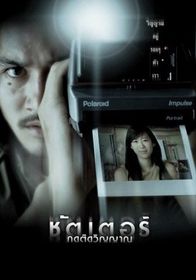Our editor-in-chief Nate Yapp is proud to have contributed to the new book Hidden Horror: A Celebration of 101 Underrated and Overlooked Fright Flicks, edited by Aaron Christensen. Another contributors include Anthony Timpone, B.J. Colangelo, Dave Alexander, Classic-Horror.com's own Robert C. Ring and John W. Bowen. Pick up a copy today from Amazon.com!
Shutter (2004)
One of the more common motivational factors in ghost stories is revenge. In this respect, Shutter, a Thai film from directors Banjong Pisanthanakun and Parkpoom Wongpoom (they also co-wrote the screenplay with Sopon Sukdapisit) is nothing new. Using the phenomenon of spirit photography as its springboard, Shutter offers a chilling, if not terribly original, story of guilt, deception, and ghostly revenge. The two directors confidently present their tale, aided by an intriguing idea and a very strong cast. This is one of the better films to come out of the recent boom of Asian horror films.
Tun (Ananda Everingham) is a young freelance photographer in Bangkok who is apparently enjoying life with his girlfriend Jane (Natthaweeranuch Thongmee). One night after getting together with their friends, Tun and Jane accidentally run over a mysterious woman. Tun convinces Jane to drive on without stopping to help or calling the police. Soon after, they both begin to experience grisly visions of the woman, as well as seeing odd, ghostly shadows in photographs. It soon becomes clear that the spirit of Tun’s former girlfriend Natre (Achita Sikamana) has returned to avenge a terrible wrong done to her by Tun and some of his friends.
One of the first things that jumps out at the audience is how seriously the filmmakers take their story. There are no cute characters or “funny” situations to provide comic relief. It seems that directors Pisanthanakun and Wongpoom realize that this story has the potential for unintended silliness, and comic relief almost always increases that potential. The ghostly apparitions in the film are not silly or ridiculous; rather they are convincing and occasionally chilling. Pisanthanakun and Wongpoom do not often linger on the ghost’s appearance, and when we do see it, we see an image that appears strangely still most of the time. They do not make the ghost of Natre look so horrific that it becomes comical. Pisanthanakun and Wongpoom also make sure that the characters are playing their characters seriously; avoiding any “humorous” fright takes or “wacky” situations. The script believes in the story instead of mocking it, and the directors take great pains to insure that they do not mock the story as well. This serious approach by the directors allows us to easily suspend our disbelief and concentrate on the tale.
As was noted above, the ghost of Natre is seen only in glimpses throughout most of the first half of the film. This keeps us guessing as to exactly what is going on, and also adds to the mystery of the strange shadows on the photographs. Also done very well is the conclusion, when Jane flips through a series of photos and sees the ghost of Natre climbing up the bookcase to find Tun’s terrible pictures of her (more about the photos below). The directors also subtly hint at the film’s twist without making it obvious. We see Tun constantly rubbing his neck, and a nurse looking suspiciously at a scale, but Pisanthanakun and Wongpoom do not focus on it. When the final twist is revealed, the directors show us glimpses of earlier scenes so we can see the pieces that led up it. Pisanthanakun and Wongpoom offer us stylish and interesting direction that keeps us both uncomfortable (in a good way) and interested.
Editor's Note: The rest of the review contains spoilers for the end of Shutter. Read at your own risk.
The most important reason for the film’s serious approach is vividly illustrated near the conclusion. There we see that Tun had photographed the vicious rape of his girlfriend Natre by some of his friends. The rape scene is presented very graphically (some viewers might be very disturbed by it), allowing us to see that the spirit of Natre has very good reasons for returning. The harshness of this scene calls to mind some of the violence of Last House on the Left, and it is not pleasant to sit through. It is a credit to the directors that they address the material with the seriousness that it deserves.
A superior cast aids Pisanthanakun and Wongpoom in telling their tale. Ananda Everingham, in particular, gives an excellent performance that grounds the story in reality. He presents us with a character that is likable and understanding, yet also frightened and weak. At first, he seems like a confident young man, sure of where he wants to go in the world. Soon, however, Everingham makes it very clear that Tun is a person who is ready to defer responsibility to anyone who will offer it, be it his friends, his girlfriend, or anyone else who will help him. Everingham often uses subtle body language to demonstrate the way he accedes to others. In difficult situations, he will often stand behind Jane, almost using her as a shield. Everingham convincingly shows us, during the rape scene, that he hates himself for doing this, but can’t bring himself to go against his “buddies.” He effectively cries and looks away while taking the awful pictures, showing us how nerveless and conflicted he is.
Natthaweeranuch Thongmee is also very strong as Jane. She plays Jane as a woman who is as self-confident and strong as Tun is weak. We see her confidently exploring an empty classroom looking for clues, and Thongmee carefully but purposefully walks through the room, showing us both her curiosity and bravery. More often than not, it is she rather than Tun who takes the lead in getting to the bottom of the mystery. Thongmee convincingly shows us that Jane loves Tun, but also that she is not dependent on him. She loudly demands answers from Tun near the end, and her face clearly show the contempt she comes to have for him.
While it inevitably has a few minor flaws (even though spirit photography is used as the springboard for the story, not much is done with the concept, for instance), Shutter, nevertheless, is a chilling and spooky ghost story that is presented very well. It has an intriguing idea, a very good cast, and two directors who pull no punches. This film is, as has been noted, one of the best films in the recent flowering of Asian horror cinema, and it is a harrowing and disturbing experience. It makes one wish that these films would stop having bland American remakes (the US Shutter pales in comparison), and instead be given greater distribution in American theaters.
This review is part of Southeast Asian Horror Week, the fourth of five celebrations of international horror done for our Shocktober 2008 event.









i'd like to know, is that
i'd like to know, is that correctly the shutter 2 is already available? is it sekuel or prekuel of this movie? i love this movie's story so much.. and i'm wonderring, bout it prekuel or sekuel. thx
There's no sequel as far as I
There's no sequel as far as I can tell. There's an American remake from 2008 and a pseudo-remake from India called Click, released in 2010.
"He went for a little walk! You should have seen his face!"